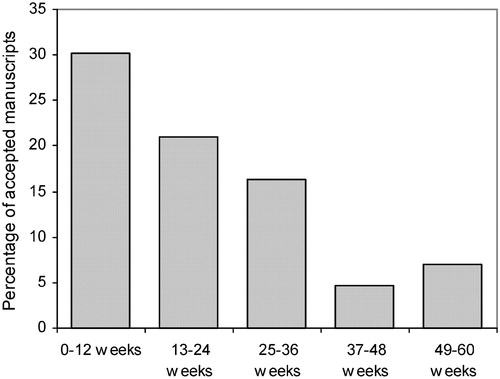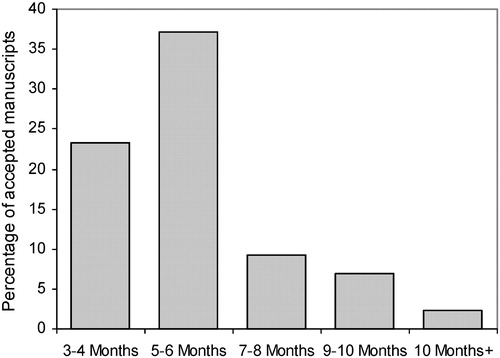The last two years or so have seen some very major changes take place within the Journal of Orthodontics. These include the introduction of statistical reviews for all scientific papers that progress beyond the standard review process, but also the introduction of a new online submission system. Such changes are likely to impact on submission to rejection or publication time, rejection rate, etc. Furthermore, some may have felt that full statistical review would discourage authors or have some other negative impact, rather than improve quality as was intended, yet the rejection rate is currently relatively low—around 35% (see ). This could even suggest that the quality of submissions has risen.
Table 1. Acceptance rates for papers submitted in the period 1 January–31 December 2005.
With such major changes occurring, it seems reasonable to review ‘how we are doing’ from the authors’ point of view (as this may influence where authors decide to submit papers), and also to suggest ways authors and the Journal can further improve and streamline matters. However, it should be noted that adding a further stage of review (i.e. statistical review) will inevitably lengthen the submission to accept or reject time; partly because the statistical reviewer has to have time to undertake the review, but also because the statistical review is likely to add to the changes the authors will be required to make. Authors failing to appropriately address the required changes (of whatever sort) in a timely manner will, of course, also lengthen the process.
All authors (and readers) want to see new, important information as soon as possible. In 2005 (the most recent year for which we have complete data), the time from submission to acceptance () was less than 6 months for over 50% of the papers accepted. However, approximately 25% took longer, but were nevertheless mostly accepted within 10 months. shows the time from acceptance to publication; by far the majority are published within 6 months (or even less), whilst only about 10% take 10 months or longer. These data compare favourably with the situation in 2002,Citation1 but we continue to strive for further improvements.
Why does anything take this time?
‘Orthodontic’ reviewers generally return reviews within 4–6 weeks, but this can take longer; more time has to be added for statistical review (and, of course, there are many fewer statistical reviewers than there are orthodontic reviewers) and where a referee with particular specialist knowledge may be especially busy. Authors should also remember that all referees give freely of their own time and are only human.
If authors are given an opportunity to revise and re-submit, then of course this, too, takes time, and it is not possible to predict how long authors will take to make the required changes, although targets are usually given. However, it is easy to see how this step can become prolonged and where authors fail to re-submit within a reasonable timescale, the paper is likely to need a fresh review.
Occasionally re-review may also be needed, if very significant changes were required. In some cases, due to the extent of revisions required it may not always be possible to decide, prior to revision, whether or not a paper is publishable. For all these reasons, submission to decision time is on average 4 months, but can be longer or shorter.
What can authors do?
Authors can speed things up by submitting papers that conform fully to the advice provided on the Journal website (http://www.maney.co.uk/journals/notes/orthodontics).
You can see what factors the referees are likely to consider by reviewing the checklists on the website (http://www.maney.co.uk/journals/notes/orthodontics#editorialprocess). Please write your paper taking these points into account.
Ethical approval is needed for most research involving patients or patient records and authors should ensure that their work complies fully with the appropriate ethical standards.Citation2 You may also be asked to supply documentary evidence of this. Animal work needs to conform to similar standards and, again, you may be required to provide evidence that it does.
Reference to other similar papers published in the Journal can also be a valuable source of information, e.g. for layout, reference style, etc.
If you are informed that the paper could be re-considered if all the changes highlighted by the referees are undertaken/addressed, please try to make the changes not only promptly, but as requested. Revisions should always be submitted in ‘track changes’ format, as this makes the process much more efficient for busy referees and editors, without whose help the Journal could not function.
What is the Journal office doing?
We regularly remind referees to return papers as soon as possible.
Referees who are unable to review at a certain time are encouraged to inform us as soon as possible, so that an alternative referee can be allocated.
We now have a team of statistical reviewers, but even so, their numbers are small compared with the number of ‘orthodontic’ reviewers.
The online system is under ongoing review to try and improve it for authors, reviewers and the editorial team.
Overall, we are performing well, but there is, as always, scope to improve things further.
References
- O’Brien K. Acceptance rates and publication times. J Orthod 2002; 29: 171.
- Luther F. Publishing without ethical approval. J Orthod 2005; 32: 2.

